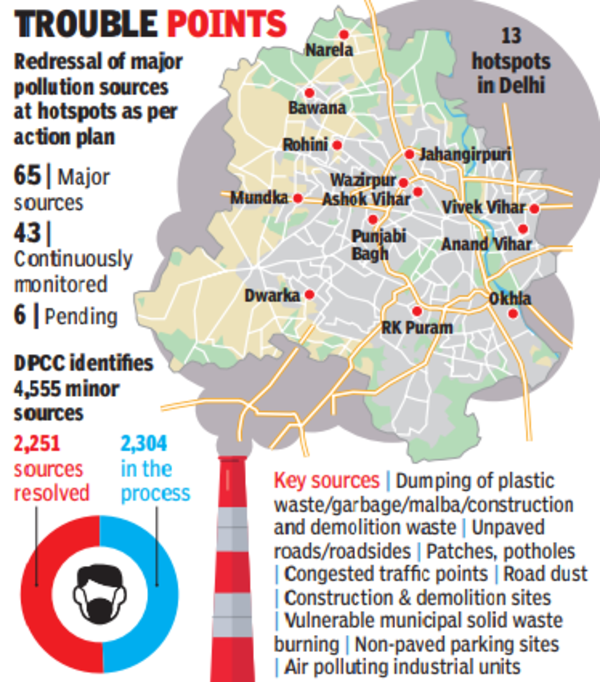Apart from the major sources, 4,555 minor sources of pollution were also identified at the 13 hotspots.Of these, 2,251 sources have been tackled while action against 2,304 sources is in process. The 13 hotspots in the city are Rohini, Vivek Vihar, RK Puram, Narela, Punjabi Bagh, Okhla, Mundka, Wazirpur, Jahangirpuri, Dwarka, Ashok Vihar, Bawana and Anand Vihar.

TOI had reported on September 29 last year that the environment department had mapped and prepared an inventory of all major and minor pollution sources along with their geo-coordinates at all the 13 pollution hotspots of the city. Based on these sources, the winter action plans for each hotspot had been prepared.
The inventory of all sources was shared with all agencies concerned so that the issues at each hotspot could be resolved.
Track the pollution level in your city
“During a review of the redressal of pollution sources at the hotspots held on January 4, it was found that of the total 65 sources of pollution in 13 hotspots, 16 sources of pollution have been dealt with. While 43 sources are being continuously monitored for the entire winter season, six pollution sources are yet to be resolved. We have asked the agencies to take care of the pending sources,” said a senior environment department official.
Officials said 49% of the total 4,555 minor sources identified at the 13 hotspots had been resolved in the past seven months. The sources of pollution included dumping of plastic waste, garbage, malba, construction and demolition waste, unpaved roads or roadsides, patches and potholes, congested traffic points, road dust, construction and demolition sites, vulnerable municipal solid waste burning, unpaved parking sites and air polluting industrial units, etc.
Of the minor sources of pollution, the majority of them fell under the jurisdiction of the Municipal Corporation of Delhi (3,248 sources), followed by PWD (420 sources). The other departments concerned include Delhi Jal Board, National Highways Authority of India, Delhi Development Authority, irrigation & flood control department and Haryana government’s irrigation department. “The principal secretary is monitoring the department-wise pendency,” revealed the official.
Experts said that to control smog episodes in winter, the hyper-local sources of pollution had to be immediately combated at the hotspots, which witness high pollution levels every year. Apart from the 13 hotspots, the environment department has recently mapped a total of 90 varied pollution sources in 24 priority areas.
In 2023, Delhi recorded an average daily PM2.5 concentration of 100 micrograms per cubic metre against 98 micrograms per cubic metre in 2022. PM2.5 concentration in 2023 was 2.5 times higher than the annual national ambient air quality standards (NAAQS) and 20 times higher than the annual WHO safe limit. The average daily PM10 concentration in 2023 was 205 micrograms per cubic metre, which is still 3.4 times higher than the annual NAAQS and 13.7 times higher than WHO’s annual safe limit.



